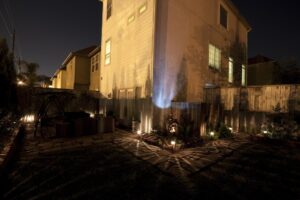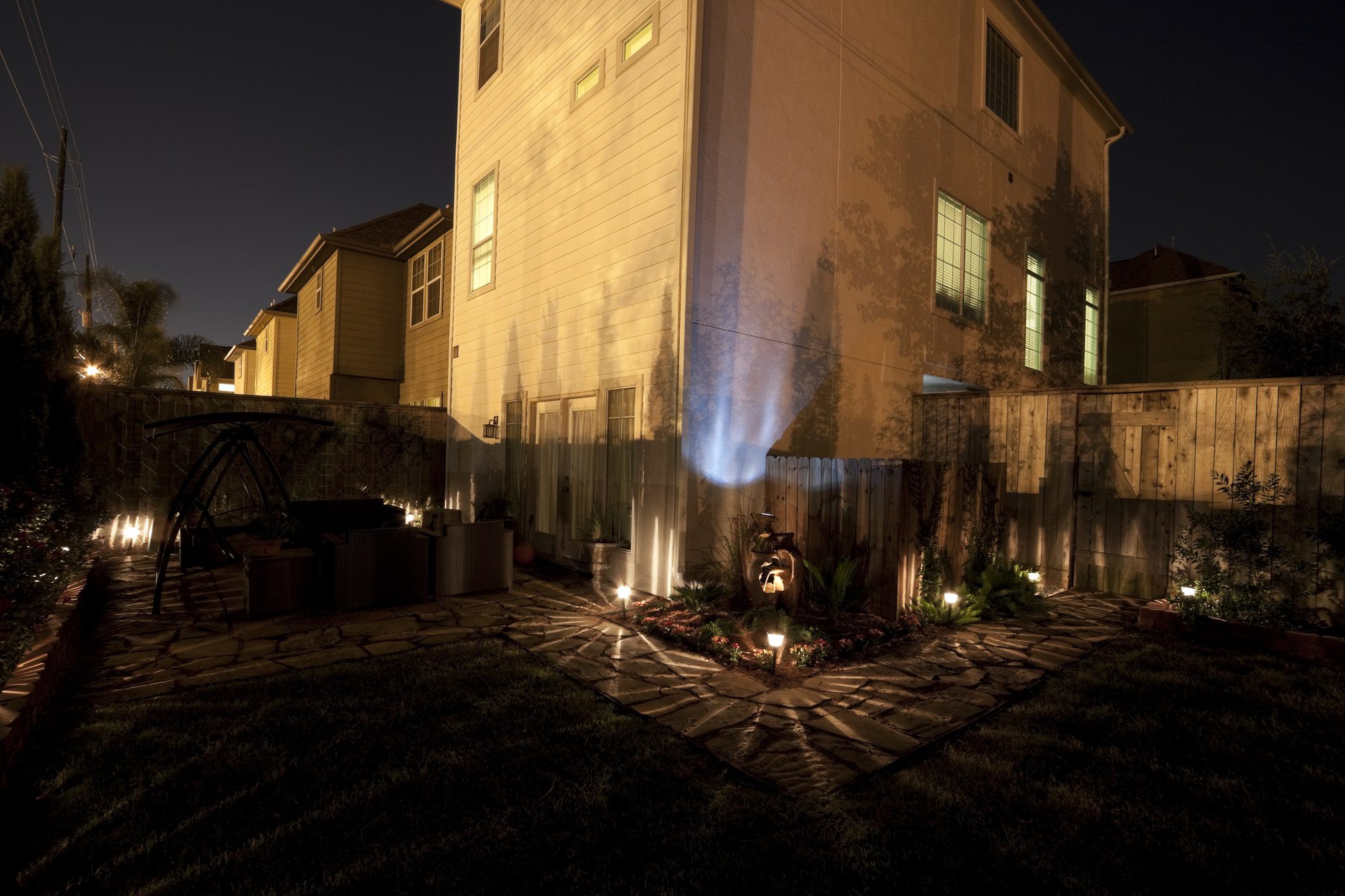Path lighting is usually one of the first types of lighting a homeowner installs. It adds safety and helps define outdoor spaces. But there are also a number of mistakes many homeowners fall into with this seemingly simple lighting feature. Just follow these path lighting tips for an outdoor nightscape that will catch the eye and make your home even more beautiful.
Path Lighting Tips To Get It Right
The right path lighting can help ensure the safety of your guests. It can also bring the outdoor spaces around your home to life after dark. But it’s not always easy to get it right. There are a number of common mistakes that homeowners make when installing path lighting. But you can avoid these mistakes and incorporate great design tips. That will ensure that your outdoor path lighting provides the resort-style glamour and inviting warmth that your home deserves.
Of course, never be shy to call in the experts, too. It’s important to know about lighting design. But a little help from the professionals at NightVision Outdoor Lighting will go a long way. It will help bring your vision to life in the best way possible. We do home, accent, path, deck, general landscape, and even holiday lighting. NightVision’s lighting professionals have your back.

Pathway lighting tips: don’t make it look like a runway. Space lights out.
How Far Apart to Install Path Lights
Path lighting tips are so important because these lights are one of the first types of landscape lighting most homeowners will install. Some systems don’t even require wiring, such as solar-powered path lights, making them an easy do-it-yourself project. However, there are some common mistakes with path lighting. Avoiding them will take your path lighting from mediocre to amazing.
- Your path is not a runway. Often homeowners place their path lights too close together. While it may seem like a good idea to get your path well lit along its whole distance, too many lights too evenly spaced can make your walkway look like a landing strip.
- Eight to six feet apart. There are no hard and fast rules about landscape lighting, but in any situation, you want to avoid putting lights closer together than six or eight feet. This helps avoid that runway feel and will force you to think more creatively about your placement.
- Path lighting is a guide. Your path lights should guide your guests down a path, not stand like sentries guarding your walkway. Place lights far apart, just to pull visitors along the path, from light to light. Don’t just light your walkway. Think of each light in terms of its landscape lighting value. If you can highlight an interesting bush or garden element (even some unique flowers), do so. You will be adding interest to the approach to your home.
- Mix and match fixtures. Avoid the little tin soldiers look. A line of the same type of lighting fixture up and down your pathway can look rigid and forced. Instead, consider each light its own landscape feature. When fixtures are properly spaced out, you can experiment with mixing different types of fixtures for a more natural look without making the fixtures look out of place.
When You Don’t Need Path Lights
path lights are an important safety feature, illuminating the right way to traverse your outdoor spaces. They also help guide guests toward your home or around your garden. But a common mistake homeowners make with path lighting is simply installing too much of it. Not every path needs to be lit. At least not with path lighting. There are other ways to light a path.
Ambient light from other landscape and outdoor lighting sources can be just as effective as path lighting. If your path is surrounded by trees, or even if there are at least a few trees along the path, consider using “moonlight” from downlighting to illuminate your pathway. It will give a natural feel without any visible fixtures.
If your path is close to your home, or if it parallels a driveway, light from the facade of the home and driveway lighting may make path lights unnecessary. Reflexively putting in path lighting just because it seems like any path should be lit is a waste of resources and may actually detract from your overall lighting design.
Providing Depth to Your Landscaping
If your home’s facade is brightly lit, or even if it is gently lit with strategic spotlights and a warm wash lighting glow, ignoring the space in front of your home can lead to a jarring, flat look. Chances are, there is some sort of path connecting the street (or at least a driveway) to your home. That path is an opportunity to break the lighting away from your home’s facade and bring it out into the third dimension, providing a depth to your lighting scheme that is much more inviting to the eye.
Placing appropriately distanced path lights along the walkway to your home creates individual spots of light that meander up towards your home, drawing the eye across the front of your property up to the magnificently lit facade.
Remember, though, that path lighting is not the only way to light a path or walkway, nor is it the only way to achieve a depth of field with your outdoor lighting scheme. If you have ornamental features in front of the home, such as a statue or a fountain, the lighting from that feature may light up much, if not all, of your path. In that case, placing path lights is both a waste of resources and visually unnecessary. The lights on the added feature will carry the lighting scheme out and away from the home, providing the depth that can make all the difference between a mediocre and a spectacular lighting scheme.
Trees can serve the same function. If you have trees along your pathway, lighting those can create focal points for the eye set apart from the facade of your home, providing the depth you need without extra path lighting. Some nice “moonlight” coming from high up in the trees can create a natural and inviting light to illuminate the path to your home without added fixtures. If you incorporate uplighting as well (to light the trees), the extra light can be more than enough to make your path to the home a safe one.
Low-Voltage Versus Solar Path Lighting
Path lighting is usually one of the first types of outdoor lighting a homeowner installs. The relative ease of installation is one major reason for that. With cheaply available self-contained, solar-powered path lights, a homeowner can run into the local hardware store, pick up a bunch of fixtures, pound them into the ground, and have a functioning path lighting system by the end of the day.
But professionals, like the pros at NightVision Outdoor Lighting, will rarely use these “plug and play” solar lights. Why not? Well, there are a number of reasons to stick to a low-voltage system, and specifically to a low-voltage LED system. One reason is manufacturing quality. The very feature that makes solar lights appealing, their low cost, is also indicative of poor workmanship. Many solar lights will break or stop working not long after they are installed. Furthermore, because the power depends on the sunlight, which varies daily, you cannot guarantee that the lighting will always look the same, even from one fixture to the other on a single day.
NightVision Outdoor Lighting uses only LED lighting in our landscape and outdoor lighting. LED lights have added efficiency and longevity that make the slightly larger upfront cost a wise investment. No one wants to be replacing bulbs in their outdoor lighting any more than they have to. Plus, when we purchase our lights in bulk, we can get savings not available to the average customer, which we pass on to you.
Getting Started With NightVision Outdoor Lighting
Path lighting is a key part of your exterior lighting plan for your home. Follow these path lighting tips to make sure you get it right. Or contact NightvVision today and leave it to the pros!
![Outdoor Path Lighting Tips [infographic]](https://nvlightingga.com/wp-content/uploads/2018/02/Outdoor-Path-Lighting-Tips-infographic-1.jpg)



